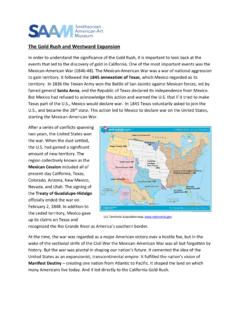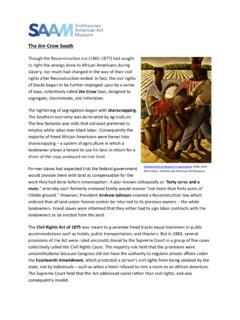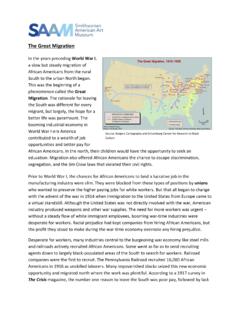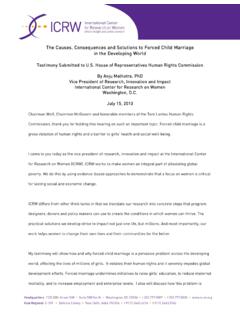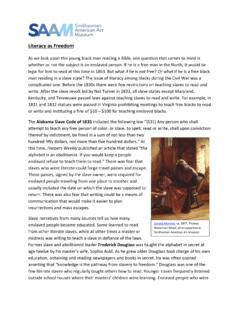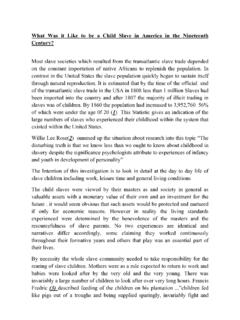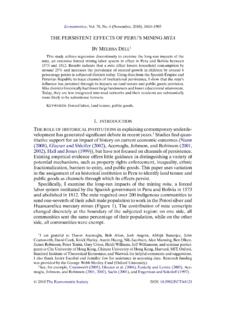Transcription of Manifest Destiny and Indian Removal - American Experience
1 Manifest Destiny and Indian Removal A convergence of several social, economic, and political factors helped urge the speed of westward expansion in the nineteenth century. Mass immigration from Europe had swelled the East Coast of the United States to record population numbers, pushing settlement westward. Expansion really boomed with the Louisiana Purchase in 1803, driving both the population and economy to the west. As the boundaries of America grew, white settlers and proponents of expansion began to voice concerns over what they considered an obstacle to settlement and America s economic and social development the American Indian tribes living on lands east of the Mississippi River which bordered white settlement.
2 The land was home to many tribal nations including the Cherokee, Creek and Seminole in the south and the Choctaw and Chickasaw in the west. That land held the promise of economic prosperity to raise cattle, wheat, and cotton, and harvest timber and minerals. Eager to take possession of the land, the settlers began to pressure the federal government to acquire the lands from the Indian tribes. To these white settlers, the Indian tribes were standing in the way of progress and of America s Manifest Destiny .
3 The self-serving concept of Manifest Destiny , the belief that the expansion of the United States was divinely ordained, justifiable, and inevitable, was used to rationalize the Removal of American Indians from their native homelands. In the minds of white Americans, the Indians were not using the land to its full potential as they reserved large tracts of unspoiled land for hunting, leaving the land uncultivated. If it was not being cultivated, then the land was being wasted. Americans declared that it was their duty, their Manifest Destiny , which compelled them to seize, settle, and cultivate the land.
4 Not surprisingly, the most active supporters of Manifest Destiny and proponents of Indian Removal were those who practiced land speculation. Land speculators bought large tracts of land with the expectation that the land would quickly increase in value as more people settled in the west and demand for that western land increased. As the western land was admitted into the Union, it would consequently increase in value. The Speculator, 1852, Francis William Edmonds The Origins of Indian Removal Though it came to fruition under Andrew Jackson s administration in the nineteenth-century, the idea of Indian Removal has its origins rooted earlier in the eighteenth-century.
5 A form of Indian Removal was first proposed by one of our Founding Fathers, Thomas Jefferson. Unlike African Americans, Jefferson believed that Indians were the equals of whites, in body and mind. Yet Jefferson found them culturally inferior due to their lifestyle and traditions. He believed that their semi-nomadic lifestyle, communal agricultural practices, and hunting traditions did not use the land efficiently. It was assumed that if the Indians adopted a European-style of agriculture and settled in European-style towns and villages only then would they progress from their natural savage state to civilization.
6 Jefferson s beliefs on civilization were formed from the Enlightenment idea of environmentalism, which dictated that a human s environment is shaped by their culture. But Jefferson s intentions were not as socially motivated as they were economic if Indians abandoned their hunting grounds that then freed up land for white settlement. The Louisiana Purchase of 1803 provided a neat solution for Jefferson, one in which Indians would not have to choose between assimilation and extermination. The government could relocate Indians further westward, delaying the inevitable acculturation, while opening up the vacated lands to white settlement.
7 Later, President James Monroe expanded on Jefferson s ideas and beliefs on Indian Removal in an 1825 address to Congress. He abandoned the idea that the Indians could be assimilated into white culture, and he argued that, therefore, it would be to the benefit of the tribes to be removed from their lands for their well-being: The Removal of the tribes from the territory which they now inhabit .. would not only shield them from impending ruin, but promote their welfare and happiness. Experience has clearly demonstrated that in their present state it is impossible to incorporate them in such masses, in any form whatever, into our system.
8 It has also been demonstrated with equal certainty that without a timely anticipation of an provision against the dangers to which they are exposed, under causes which it will be difficult, if not impossible to control, their degradation and extermination will be inevitable. Thomas Jefferson, 1805/1821, Gilbert Stuart, National Portrait Gallery, Smithsonian Institution While Indian Removal as a policy was first envisioned by Thomas Jefferson, and structured by James Monroe, it was Andrew Jackson who fully realized Removal , pushing the policy into law.
9 Jackson had long been a supporter of Removal . Prior to his presidency, he had commanded military forces in Georgia, Alabama, and Florida to quell Indian resistance to white expansion and settlement. He also negotiated several treaties in the 1810s and 1820s which divested southern Indian tribes of their eastern land in exchange for land in the west. Jackson offered his own justification for Indian Removal in December 1829, claiming that the Removal was necessary for the preservation of American Indians essentially asserting that Removal was a humanitarian act for the good of the Indian tribes.
10 [The Indians ] present condition with what they once were , makes a most powerful appeal to our sympathies. Our ancestors found them the uncontrolled possessors of these vast regions. By persuasion and force, they have been made to retire from river to river, and from mountain to mountain; until some of the tribes have become extinct, and others have left but remnants, to preserve, for a while, their once terrible names.. This fate surely awaits them, if they remain within the limits of the States, does not admit of a doubt.


